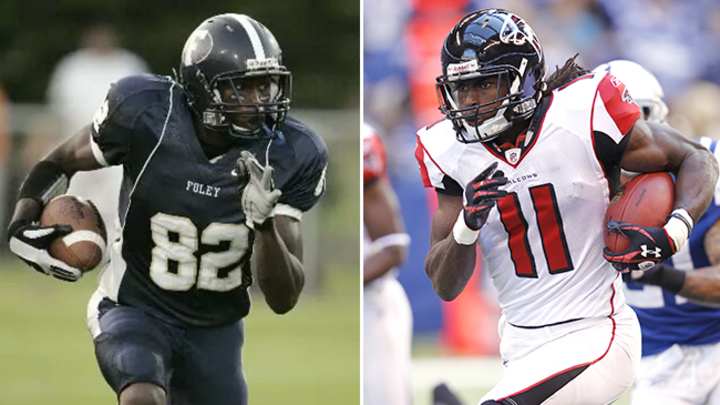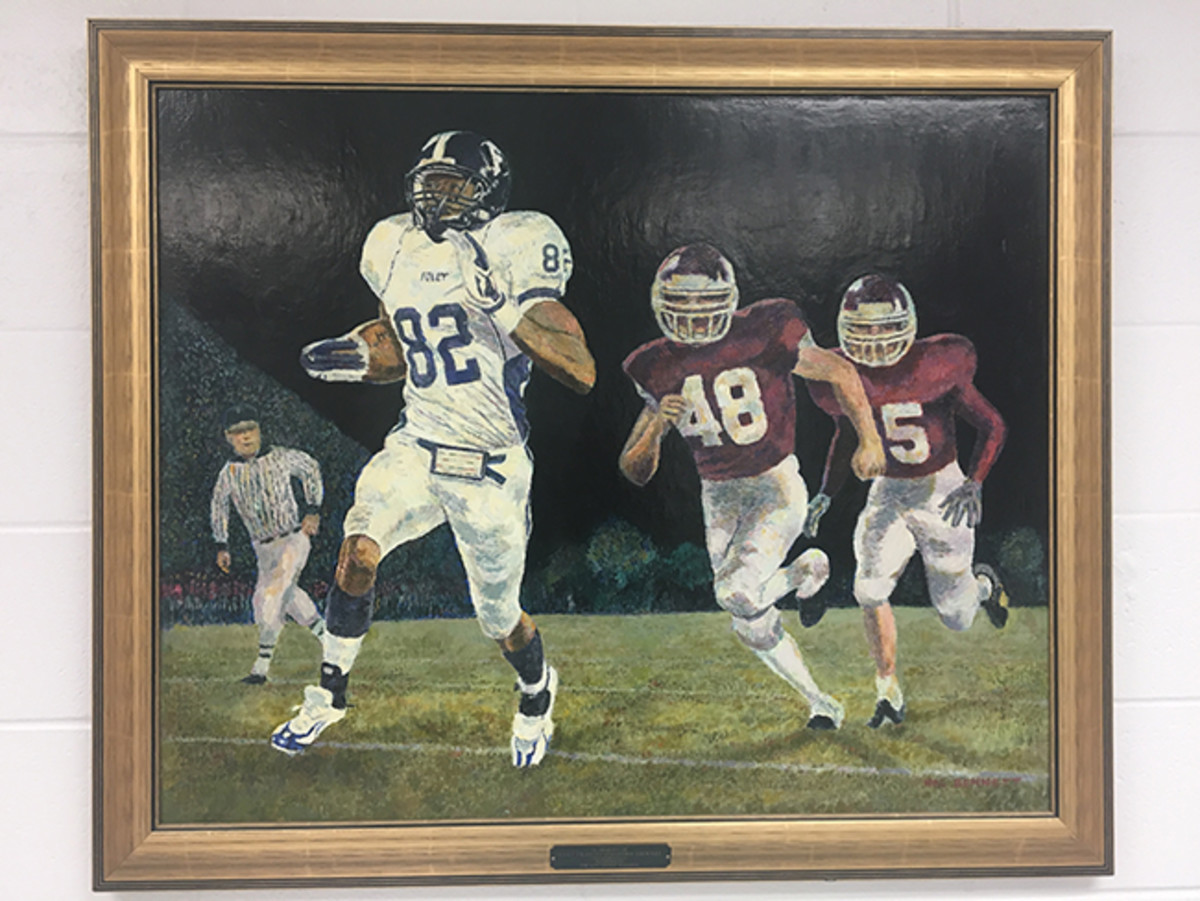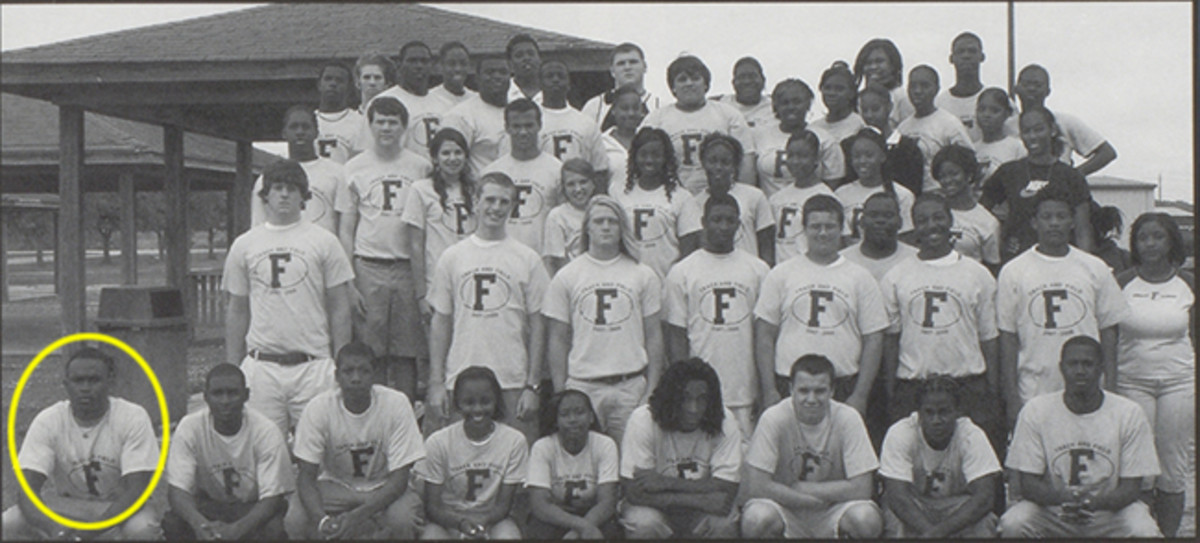The Ballad of Quintorris Jones

The MMQB is on the road to Super Bowl 51. Follow along on Twitter, Facebook, Instagram and Snapchat (@TheMMQB), and find all of our Road to Houston content here.
FOLEY, Ala. — In the spring of 2007, a particularly gifted jumper named Quintorris Jones began appearing in high school track and field results across Alabama, as well as in the top meets in adjoining states. He did the long jump, the high jump, the triple jump. Quintorris Jones was so explosive that he could fly farther on a standing triple jump than most of his opponents could with the benefit of the running start.
A coach from a Big Ten program called Foley High School, wanting to learn more about this young athlete. As he spoke to Foley’s coach, D.D. Andersen, he became confused. She kept referencing Julio Jones, who at that time was considered the No. 1 football recruit in the nation by numerous media outlets. I appreciate the information, he told her, but I am calling to talk to you about Quintorris Jones.
“Oh, I’m so sorry,” Andersen replied. “That’s the same person.”
This was Jones’ junior year of high school, and by that point the hype around him had reached such a fever pitch that Andersen had taken to entering him in meets by his given name, Quintorris, rather than the nickname, Julio, that he’d gone by ever since his mother gave it to him as a middle-schooler.
“He didn’t really like the hype,” Andersen recalls. “He just wanted to compete. Be him. And didn’t want the limelight.”
Not much has changed. While wide receiver peers like Antonio Brown and Odell Beckham Jr., drew scrutiny this postseason (for starring in a post-game locker room Facebook Live, and posting photos of an off-day yacht excursion with Justin Bieber, respectively) the Falcons’ quiet superstar was in the headlines only for his performance, including 180 yards and two touchdowns in the NFC championship game to help launch his team to Super Bowl 51.

Here in his hometown of Foley, Alabama, with its old-town feel (the main drag includes a drugstore with a soda fountain and a jukebox that plays vinyl records), about 20 minutes from the Gulf of Mexico, Jones has been a household name since he became old enough to drive. A one-word moniker—“Julio”—that became a sing-songy cheer by the fans who came from near and far to catch a glimpse of him playing on the same football field where Ken Stabler once starred.
Just as big a part of Jones’ legend to this day, though, is how much he resisted being seen as one. Recruiters from all the top college football programs would come to town and leave bewildered. Jones didn’t want to talk about himself. And he didn’t really want to talk about football, because that would require talking about himself. Finally, one of the Alabama recruiters uncovered the one thing Jones would discuss at length: The Discovery Channel show, Mythbusters.
“The word got out,” says Foley High School principal Russ Moore. “I think he had four, five recruiters there watching Mythbusters for a couple months, just so they’d have something to talk to Julio about.”
* * *
At age 5, Jones declared that he wanted to play football. His reason was simple: His father had just left their family behind, and this was a little boy’s way of assuring his mama that they would be O.K. Queen Marvin, his mother, supported the family by working long shifts at fast-food restaurants. First it was Church’s Chicken; then, she spent nearly 10 years at the KFC right next to the high school. “He said, all you do is work, work, work,” Marvin says. “He told me he’d buy me the house I never had, the car I never had and that I wouldn’t have to work no more.”
That was Jones’ motivation to play professional football. It wasn’t the fame. In fact, Jones is still oblivious to that side of the equation. In a training-camp conversation last summer, Jones described how, as a kid, he rarely watched football. “I saw one clip of Barry Sanders, on ESPN, like just a clip,” Jones recalled. He loves football, but he doesn’t watch it on TV. It’s a peculiarity that is true to this day (outside of game film, of course).
Jones was a running back until his sophomore year of high school, when Todd Watson took over the Foley program. At 6' 3" and about 200 pounds in those days, Jones dwarfed his peers, and he was stronger than most defensive linemen. Watson moved him to receiver and installed a spread attack, out of which they’d throw 60 to 65 percent of the time. The summer before Jones’ junior year, the team went to a national 7-on-7 tournament near Birmingham. That’s when his name caught fire.

Jones seemed to pull off an uncommon feat in every sport he competed in. During his senior year, a Thursday night game against rival Daphne was broadcast nationally on ESPN2. Jones hurt his ankle in the first half, and Watson came out of the locker room at halftime unsure if his star player would return. Late in the third quarter, Jones reappeared on the sideline, ready to go back in. Shortly thereafter, he proceeded to make an acrobatic catch over two defenders for the game-winning touchdown, bad ankle and all.
Local broadcaster Clark Stewart, who called Jones’ games for WHEP Radio 35 years after his father broadcast Kenny Stabler’s games, refers to that as “The Catch.” From his radio call that night, October 2007: Julio down there, and Jones rips it out of his hands of the defender. Touchdown, Julio Jones! Touchdown, Foley Lions! What a play! If you are near a TV, go turn it on ladies and gentlemen. That was a play. And listen to this crowd!
During basketball season later that year, during a 2008 playoff game against LeFlore High School, there was a play Stewart calls “The Dunk.” A teammate threw up a long-range three that hit the back of the rim and bounced out, when Jones came flying in for a monster slam. Stewart was broadcasting that game with Watson, the football coach, who was rendered speechless, even after coaching Jones for three years.
Watson: Wow. Wow. I can’t think of anything else but, wow. I don’t know where he came from.
Stewart: Coach, he came down from that steel structure about 10 feet above the rim. Unbelievable.
Watson: He’s got everybody in the house stirred.
Stewart: I’m not sure I can even call a break here.
Jones did everything he could to duck the attention. A night out meant going to the movies with his mom; she’d go to see one film, and he’d go to see another. At one track and field meet, another competitor approached him and asked, “Are you Julio Jones?” Jones pointed to a teammate and said, “No, he is.”
But every coach in America knew where to find him. On the ESPN2 broadcast of the game against Daphne his senior year, they reported Jones as having more than 50 offers from schools across the country. Shane Jones, his receivers coach at Foley (no relation), recalls one afternoon when Jones was meeting with Nick Saban inside the high school. Urban Meyer, Bob Stoops and Tommy Tuberville all waited outside in the parking lot for their turn. They flooded Foley, to the point where Jones had to put his own limits on when recruiters could meet with him, because he didn’t want to keep missing class.

When NCAA recruiting rules still allowed it, Foley would host a spring football jamboree, inviting Alabama schools with top prospects to come play in a showcase for college coaches. It was a big deal, but never quite like the spring of Jones’ junior year, which was also Saban’s first year at Alabama. “A few days prior to the jamboree, I start getting calls asking if there is a place to park an RV,” Watson recalls. “I said, there’s a little room, enough to probably accommodate one or two. Well, the day before the game, we had 18 to 20 RVs pull up in.”
A chapter of Alabama’s Red Elephant Club had come to tailgate Foley’s spring game. They came to see Saban. And they came to see Julio.
* * *
Not long after Jones had been drafted by the Falcons in 2011, he came back to Foley to watch a football game. He didn’t want to cause a fuss, so he asked Moore, the principal, to sneak him in through one of the end zones. But Jones stood out just as much as he did in the 2005 Foley track and field team photo, where he’s twice the size of the kid sitting next to him, as a freshman. Something of a scene broke out at Ivan Jones Field.
“This is kind of a common sense place—at least I always thought so—but then you have people try to rush the field when he is on the sideline and needed security,” Moore says. “I would never have dreamed that normal people I see every day at Wal-Mart would try to climb over a fence to get somebody’s autograph in the middle of a ballgame. Of course he was embarrassed and mortified, and we got it under control, but…”
Jones came to the game with his former Alabama teammate, running back Trent Richardson, who would be drafted in the first round one year later. After security had gotten the field rush under control, a young fan was yelling Richardson’s name over and over. When Richardson turned around to say hello, Moore recalls, the kid blurted out, “Can you get me Julio’s autograph?”
“Here in his hometown,” Moore adds, “I think Julio would have a hard time walking into Wal-Mart without it being weird.”
He comes back for his mama, and he’s kept the promise he made to her at age 5. Marvin worked at KFC all the way up to his draft day, in April 2011. Soon after, he drove up to the new house he bought her, in her new Cadillac Escalade, with one of those big red bows on top. Even so, just last week a friend spotted Marvin at the going-out-of-business sale for a local hardware store. She was waiting in line, so unchanged by her son’s success that she still wanted to save a few bucks on a broom and a bucket.
Back in her son’s high school days, Marvin would ride the fan bus to away games.
Whenever she was asked which player was her son, she’d never say, “Julio.” It was always, “Quintorris.” This was the example for the quiet superstar from Foley, who has done everything he can to be inconspicuous off the field, while becoming impossibly conspicuous on it.
Question or comment? Email us at talkback@themmqb.com.
